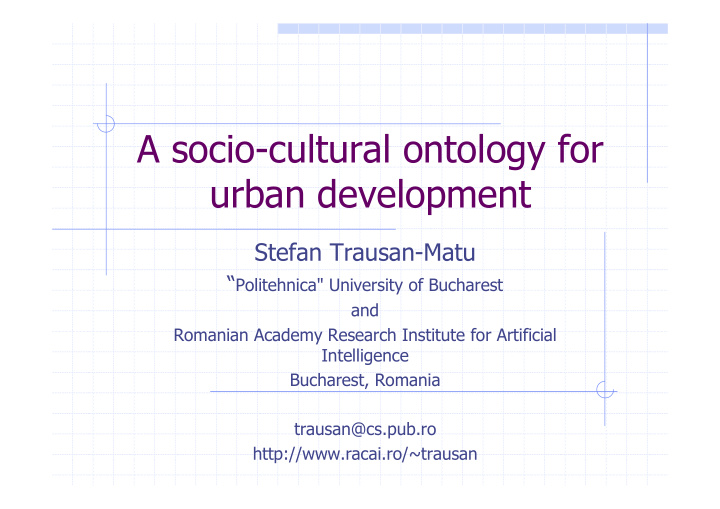



A socio-cultural ontology for urban development Stefan Trausan-Matu “ Politehnica" University of Bucharest and Romanian Academy Research Institute for Artificial Intelligence Bucharest, Romania trausan@cs.pub.ro http://www.racai.ro/~trausan
Methods for ontology development Ad-hoc Formal concept analysis Psycholinguistics (WordNet) Starting from a thesaurus, a Data Base, a taxonomy or other structured repositories Ontologies alignment Knowledge extraction from texts (text mining) Starting from philosophical categories (e.g. Sowa) 6 November 2006 Towntology, Geneva 2
Philosophical paradigms Cognitive science: “knowledge is in the mind of individual persons” (Cyc, WordNet, FrameNet, Mikrokosmos, Sowa …) Socio-cultural: “knowledge is social, is in communities where people enter in dailogs” (Vygotsky, Engeström, Stahl …) 6 November 2006 Towntology, Geneva 3
Why a socio-cultural paradigm? Cognitive science and artificial intelligence problems Considering socio-cultural issues in urbanism Supporting dialogism Group knowledge construction Conflict resolution Reaching common meaning through dialog 6 November 2006 Towntology, Geneva 4
Methodology Combination of Pierce’s categories Individuals Relations Triples Engeström’s theory of activity Hewit’s use of triangles in Engeström’s diagram 6 November 2006 Towntology, Geneva 5
Basic Categories in Sowa’s Ontology (including Pierce’s categories) 6 November 2006 Towntology, Geneva 6
Vygotsky’s mediating triangle 6 November 2006 Towntology, Geneva 7
The activity diagram of Engeström 6 November 2006 Towntology, Geneva 8
1. Individuals Subjects Objects Communities General artifacts Social rules Division of labor 6 November 2006 Towntology, Geneva 9
Subjects may be classified in several ways, considering different aspects: earnings, social status, ethnicity, age, hobbies, religion, etc. these aspects may be either the basis of a taxonomy of concepts or of attributes. For example, a person that has a habit of walking in a park may either be a new concept, which inherits from the subject concept, or an instance of the subject having “walking in a park” as the habit attribute. 6 November 2006 Towntology, Geneva 10
Objects buildings, roads, parks, cars, etc. each of these concepts may be the root of an entire ontology. For example, buildings may be classified in living houses, offices buildings, theaters, cinemas, sport halls, hospitals, factories, shops, etc. 6 November 2006 Towntology, Geneva 11
Communities may be classified in the socio-cultural ontology according to several criteria, some of them derived from subjects’ attributes like religion or ethnic group. 6 November 2006 Towntology, Geneva 12
General artifacts may be physical (tools, objects with a given use, that means that a sub- concept of the object category may be meanwhile a sub-concept of the artifact category), symbolic (texts, prices, taxes) mental (e.g. imagery, visual patterns, architectural styles). 6 November 2006 Towntology, Geneva 13
Social rules may be legislation, traffic rules, unwritten behavior laws or esthetics. Rules may also become artifacts (sub- concepts of the rule category may be also sub-concepts of the artifact category), used by objects in communities. 6 November 2006 Towntology, Geneva 14
Division of labor is a basis for the taxonomy of services that assure the functioning and the quality of life of communities (providers of electricity, water and gas, teaching, police, fire department, administration, etc.) 6 November 2006 Towntology, Geneva 15
2. Relations subject – object (owned buildings and cars) subject – rules subject – community community – rules community – object (e.g. buildings, cars, parks) community – divisions of labor (e.g. roles) community – artifacts (e.g. beliefs, documents like acts) object – artifact (property acts, blueprints) object – subject (owner) object – rule (of use) 6 November 2006 Towntology, Geneva 16
3. Triples May be triangles in the activity diagram Other mediating artifacts 6 November 2006 Towntology, Geneva 17
Image of rules in communities 6 November 2006 Towntology, Geneva 18
Artifacts of subjects in communities 6 November 2006 Towntology, Geneva 19
Roles of individuals in a community 6 November 2006 Towntology, Geneva 20
Rules for objects’ use in a community 6 November 2006 Towntology, Geneva 21
Rules (laws) that apply to an individual in relation to an object 6 November 2006 Towntology, Geneva 22
The “mountain_house” “artifact_community_rule” triple and some related concepts. 6 November 2006 Towntology, Geneva 23
The OWL description of the mountain_house concepts. <owl:Class rdf:ID="mountain_house"> <rdfs:subClassOf rdf:resource="#artifact_community_rule"/> <rdfs:subClassOf> <owl:Restriction> <owl:hasValue rdf:resource="#build_with_wood"/> <owl:onProperty> <owl:ObjectProperty rdf:ID="t_rule"/> </owl:onProperty> </owl:Restriction> </rdfs:subClassOf> <rdfs:subClassOf> <owl:Restriction> <owl:onProperty> <owl:ObjectProperty rdf:ID="t_artifact"/> </owl:onProperty> <owl:hasValue rdf:resource="#mountain_house_image"/> </owl:Restriction> </rdfs:subClassOf> </owl:Class> 6 November 2006 Towntology, Geneva 24
The OWL description of the t_community property. <owl:ObjectProperty rdf:ID="t_community"> <rdfs:domain> <owl:Class> <owl:unionOf rdf:parseType="Collection"> <rdf:Description rdf:about= "http://www.w3.org/2002/07/owl#Thing"/> <owl:Class rdf:about="#mountain_house"/> </owl:unionOf> </owl:Class> </rdfs:domain> </owl:ObjectProperty> 6 November 2006 Towntology, Geneva 25
Further work Develop the socio-cultural ontology Develop software for conflict management in dialogs, based on ontologies Ontology extraction from dialogs Ontology-based applications for urbanization in Romania 6 November 2006 Towntology, Geneva 26
Recommend
More recommend